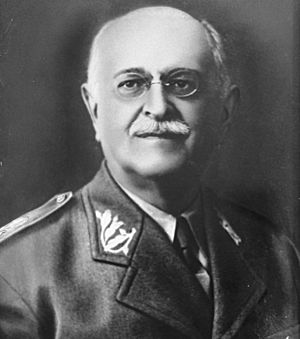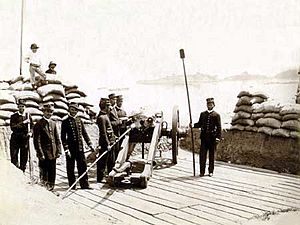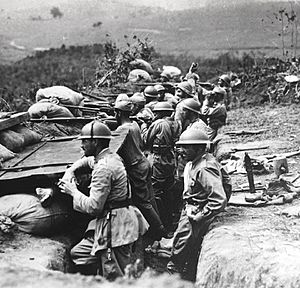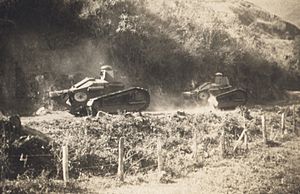Augusto Tasso Fragoso facts for kids
Quick facts for kids
Augusto Tasso Fragoso
|
|
|---|---|
 |
|
| President of the Brazilian Military Junta | |
| In office 24 October 1930 – 3 November 1930 Serving with Isaías de Noronha, Mena Barreto
|
|
| Preceded by | Washington Luís (as President) |
| Succeeded by | Getúlio Vargas (as President) |
| Justice of the Superior Military Court | |
| In office 28 April 1933 – 19 February 1938 |
|
| Nominated by | Getúlio Vargas |
| Preceded by | Mena Barreto |
| Succeeded by | Raimundo Rodrigues Barbosa |
| Chief of the General Staff of the Army | |
| In office 31 March 1931 – 22 August 1932 |
|
| President | Getúlio Vargas |
| Preceded by | Alfredo Malan D'Angrogne |
| Succeeded by | Francisco Ramos de Andrade Neves |
| In office 21 November 1922 – 24 January 1929 |
|
| President | Artur Bernardes Washington Luís |
| Preceded by | Fernando Setembrino de Carvalho |
| Succeeded by | Alexandre Henriques Vieira Leal |
| Personal details | |
| Born | 28 August 1869 São Luís, Maranhão, Empire of Brazil |
| Died | 20 September 1945 (aged 76) Rio de Janeiro, Federal District, Brazil |
| Spouse |
Josefa da Graça Aranha
(m. 1895) |
| Children | 6 |
| Parents | Joaquim Coelho Fragoso (father) Maria Custódia de Sousa (mother) |
| Military service | |
| Allegiance | |
| Branch/service | |
| Years of service | 1885–1945 |
| Rank | Divisional general |
| Commands |
|
| Battles/wars |
|
General Augusto Tasso Fragoso, known as Tasso Fragoso, was a Brazilian soldier, judge, and writer. He was born in São Luís, Maranhão, on August 28, 1869, and passed away on September 20, 1945.
He played a key role during the Revolution of 1930. For a short time, from October 24 to November 3, 1930, he was the president of the Provisional Government Board. This group led Brazil after President Washington Luís was removed and before Getúlio Vargas took office.
Tasso Fragoso was also the first person from Maranhão to become a leader of Brazil. He was a cousin of the Portuguese President António Óscar Fragoso Carmona.
Contents
Early Life and Education
Augusto Tasso Fragoso was born in São Luís, the capital city of Maranhão, in 1869. Interestingly, his official documents sometimes said he was born in 1867. This change was made by his father so Tasso could start his military career earlier.
His mother, Maria Custódia de Souza Fragoso, was from Pará, Brazil. His father, Joaquim Coelho Fragoso, was from Portugal. Joaquim was a manager of a shipping company and later became a vice-consul for Portugal in Brazil.
Military Career
Joining the Republic
As a young soldier in Rio de Janeiro, Tasso Fragoso learned about positivist ideas from Benjamin Constant. These ideas were about using science and reason to improve society.
In January 1889, he became an alferes-aluno (an officer cadet). He studied at the Superior War College, focusing on mathematics and engineering. During this time, he helped plan the movement to establish the Republic in Brazil.
In October 1889, tensions were high between the emperor, Dom Pedro II, and the army. Tasso Fragoso spoke for his fellow students, showing their support for Benjamin Constant and the upcoming changes in Brazil.
On November 15, 1889, when the Republic was about to be declared, Tasso Fragoso joined other soldiers. They waited for Benjamin Constant and General Manuel Deodoro da Fonseca. He helped confirm the navy's support for the movement that ended the monarchy and started the new republican government.
Early Military Roles
In 1891, Tasso Fragoso became the Head of the Department of Works and General Transportation for the Federal District (which was Rio de Janeiro at the time). He held this position until April 1892.
In 1893, he helped put down the Revolta da Armada (Navy Revolt). This revolt tried to overthrow the government of Floriano Peixoto. Tasso Fragoso remained loyal to the government.

In 1908, he traveled to Europe as part of the team for the Minister of War, Hermes da Fonseca.
Serving Abroad and at Home
In July 1909, Tasso Fragoso was appointed as a military representative in Argentina. He was promoted to lieutenant colonel in December of that year.
He returned to Brazil in July 1910 and took command of the 8th Cavalry Regiment. He also temporarily led the 2nd Brigade of Cavalry.
In 1914, President Venceslau Brás appointed him as Head of the Military House. He stayed in this role until 1917. During this time, he was important in starting compulsory military service and updating the Army as Brazil prepared for World War I.
Becoming a General
Tasso Fragoso became a general in 1918. On November 21, 1922, he was made Chief of Staff of the Army. He held this important position until January 24, 1929. He helped modernize the Army with the help of the French Military Mission.
He resigned from this role in 1929 because he disagreed with decisions about how military education in Brazil should be organized.
The 1930 Revolution
Tasso Fragoso was focused on his military career and usually stayed out of politics. He even refused an invitation to join the Revolution of 1930 at first.
However, fighting broke out between the government and the revolutionaries. General Mena Barreto asked Tasso Fragoso to lead the military operation. As the most experienced officer, he was asked to help bring peace to the country and remove President Washington Luís.
So, Tasso Fragoso, along with General Mena Barreto and Rear Admiral Isaías de Noronha, led the Junta Governativa. This group took over from the deposed President and handed power to Getúlio Vargas, who led the revolutionary forces.
On March 30, 1931, he returned to lead the Army's General Staff. He then helped fight against the Constitutionalist Revolution of 1932. However, he felt left out of the most important decisions in that campaign. So, he resigned again on August 22, 1932.
Judge in the Military Court
On April 22, 1933, he was appointed as a Minister (judge) of the Supreme Military Tribunal (STM). He served in this role until February 19, 1938, when he had to retire because of the age limit.
Interestingly, Tasso was actually 66 years old at that time, not 68. His father had increased his age when he enrolled him in military school so he could start earlier. His friends knew this and suggested he correct his age. But Tasso Fragoso refused, saying it wouldn't be honest to benefit from his father's action for years and then change it for personal gain.
Later Life and Legacy
Tasso Fragoso passed away in Rio de Janeiro in 1945, at 76 years old. A street in the Lagoa neighborhood, where he lived, is named after him. The city of Tasso Fragoso, in Maranhão, is also a tribute to his name.
Family Life
He married Josefa Graça Aranha in 1895. She came from a well-known family in Brazil.
Tasso Fragoso and Josefa had six children. Some of them were:
- Evangelina: Her children formed the Fragoso Pires family.
- Murilo: A diplomat, he had two daughters.
- Beatriz: She also had descendants.
- Heloisa: She had two children.
- Marina.
Writings
Tasso Fragoso wrote several technical and historical books. Some of his notable works include:
- 1922 – A batalha do passo do Rosário (The Battle of Passo do Rosário)
- 1934 – História da guerra entre a Tríplice Aliança e o Paraguai (History of the War between the Triple Alliance and Paraguay) – a large work in 5 volumes.
- 1938 – A Revolução Farroupilha (1835-1845) — narrativa sintética das operações militares (The Farroupilha Revolution – a summary of military operations)
- 1940 – Revolvendo o passado (Revisiting the Past)
See also
 In Spanish: Augusto Fragoso para niños
In Spanish: Augusto Fragoso para niños



